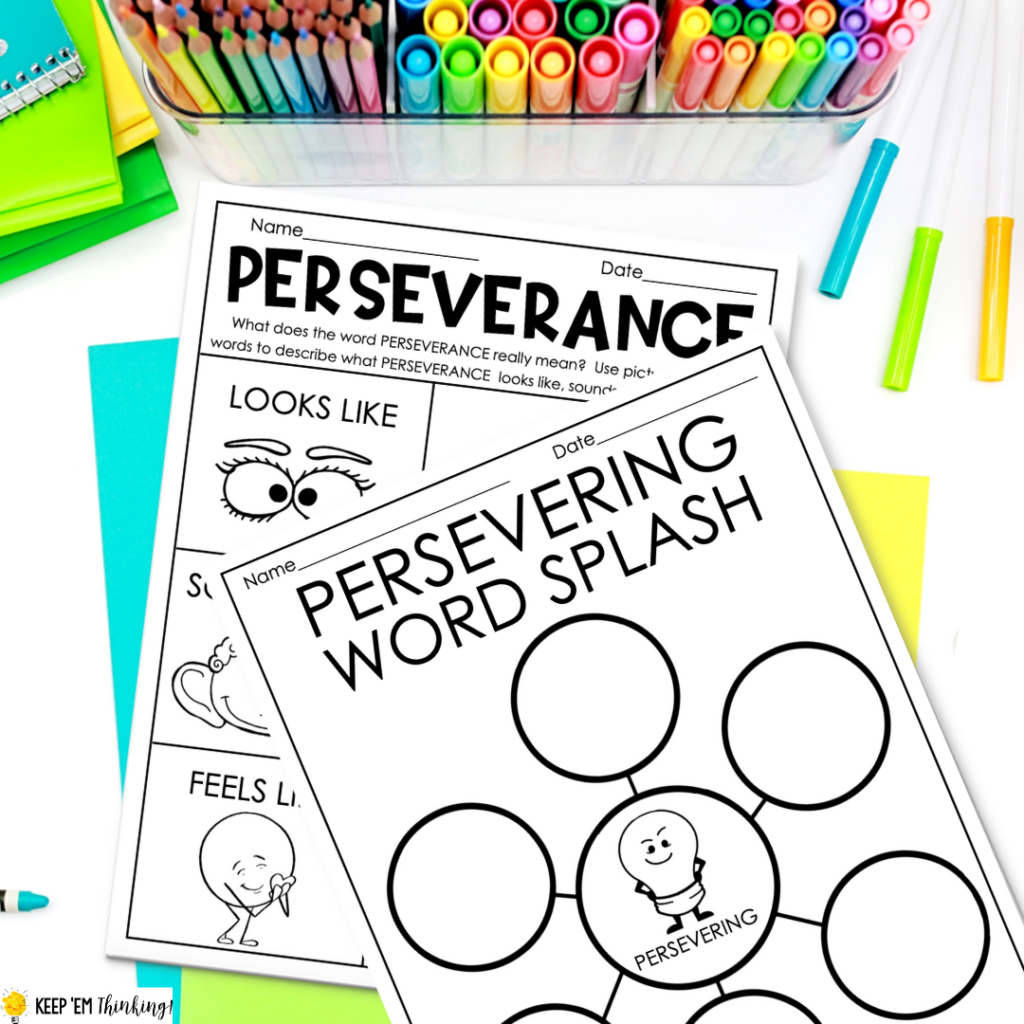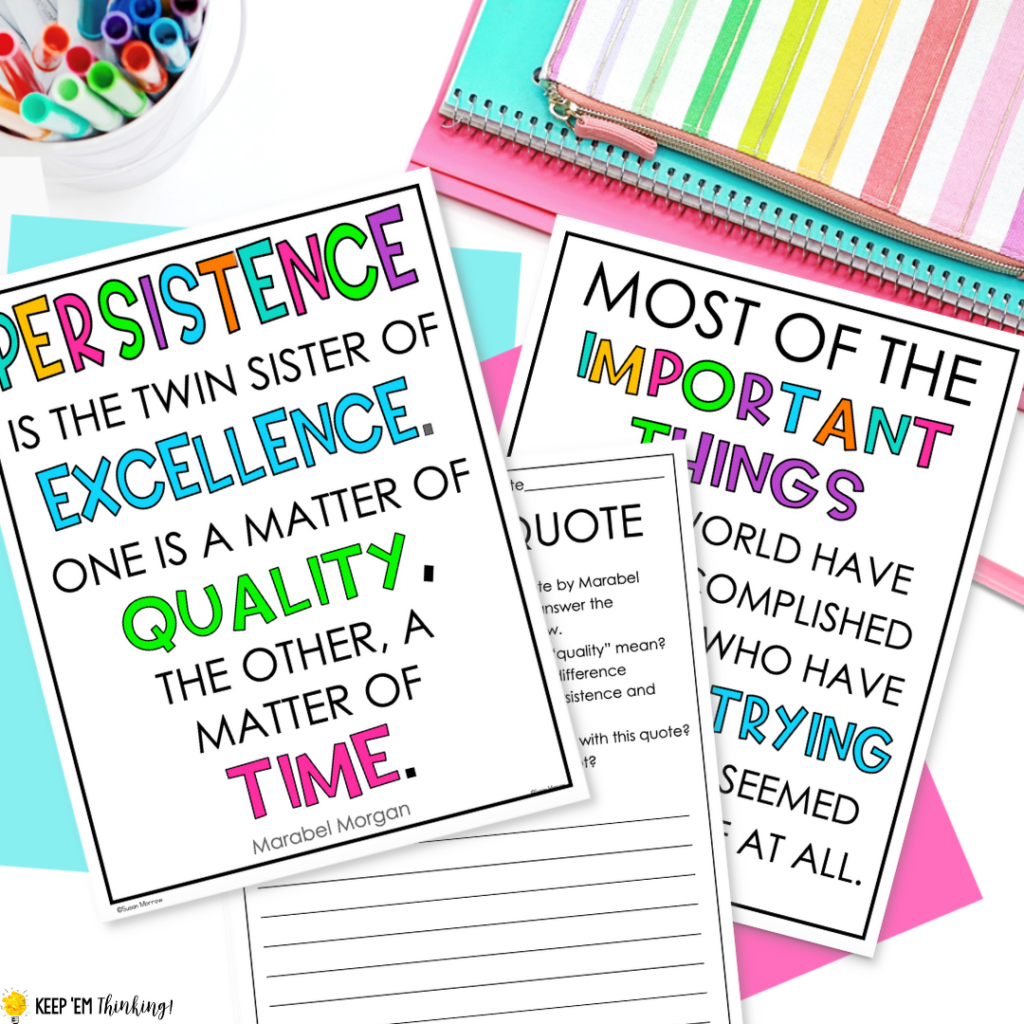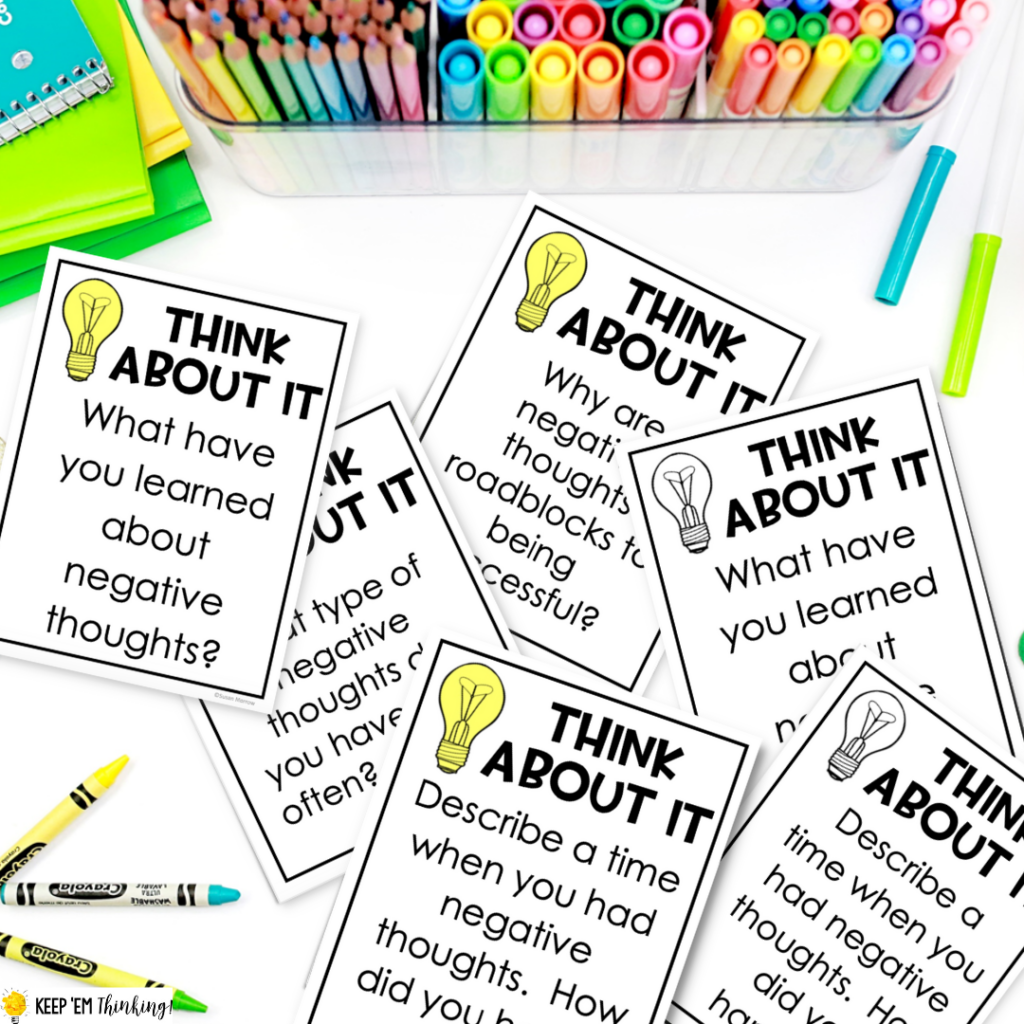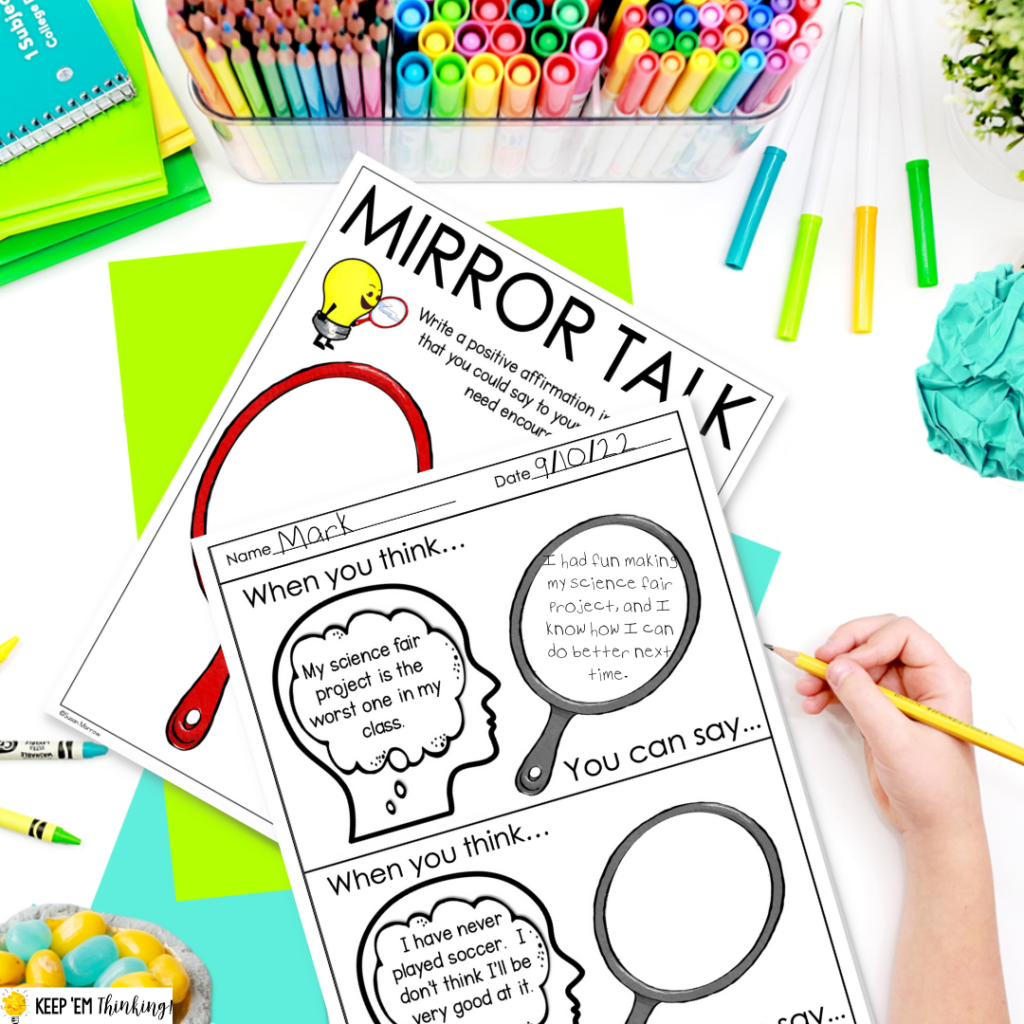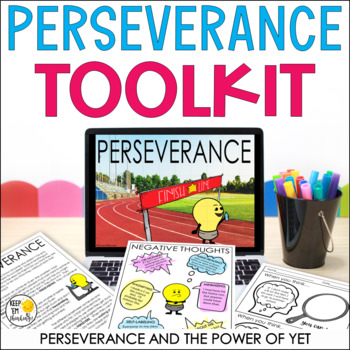The world today is one of instant gratification. The saying what gets rewarded gets repeated is so true, especially for kids. If you reward mediocre performance and effort in your classroom, that is what you will always get. Instead, teach your students the power of perseverance! Teaching perseverance may sound difficult but it doesn’t have to be. Here’s everything you need to know!
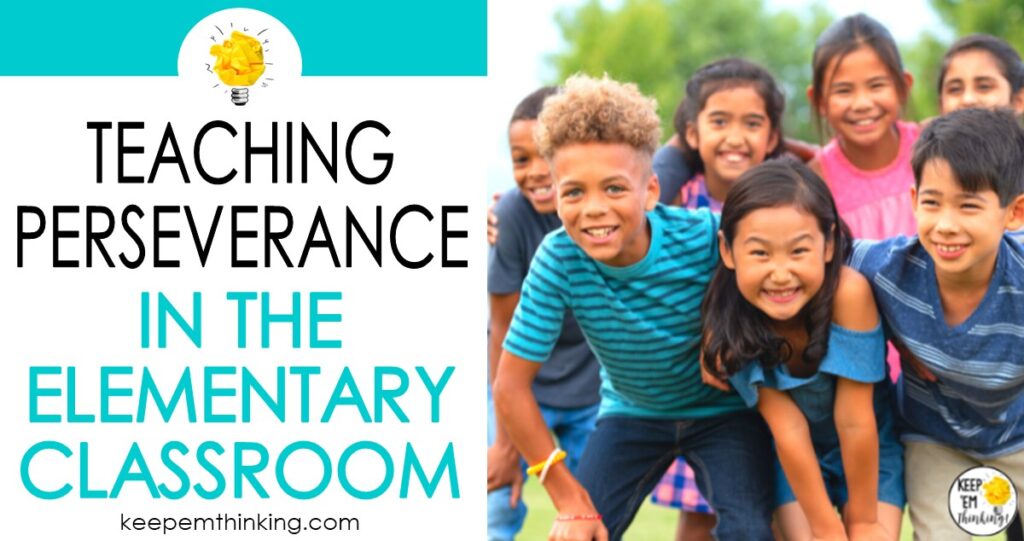
When faced with a challenge, many of our students don’t know about perseverance. Instead, you often hear comments such as, “I don’t know,” or “This is too hard.” You may hear “I can’t do this,” or “I’m done.”
In our quest to help all our students become achievers, we need to teach them perseverance when faced with a challenge or a problem they don’t know the answer to. We need to teach them how to keep going, how to fail, and try again. We need to teach perseverance!
Teachers and parents need to explicitly teach their children what perseverance is and specific strategies they can use when they get stuck.
Teach by Example
There are many ways you can teach perseverance in your classroom. I have found that one of the most effective ways to teach perseverance is by example. History is filled with real-life stories of perseverance. Play-Doh, for example, was originally created as a wallpaper cleaner. The inventors persevered and now the world has an amazing toy!

Did you know that Michael Jordan was cut from his high school basketball team? The book, Salt in His Shoes, tells the true story of how Jordan persevered through trials to become one of the most famous basketball players in the world.
And we can’t forget about Thomas Edison. This great inventor is a great example of perseverance. After failing hundreds, if not thousands of times, he finally created a light bulb that worked as intended.
You can find videos and books about so many real-life perseverance heroes. These make great introductions to the teaching of perseverance.
Perseverance Activities
Read-Alouds
Read-alouds are a great way to teach students how to persevere! There’s something about a story, fiction or non-fiction, that really engages students. Once drawn in, they can see the struggle and perseverance in a way that allows them to connect it to real life.
The Most Magnificent Thing, by Ashley Spires, has great tie-ins to a unit on perseverance. It’s the story of a girl and her dog. The girl has an idea and declares she is going to make the most magnificent thing. Unfortunately, it doesn’t turn out as she imagined. She gets mad and quits. Her dog convinces her to step away and come back with a positive attitude to get her magnificent idea right.

After reading this book, take time to have a meaningful discussion with your students. Ask them questions to get them thinking and then let the conversation take over. Questions like, “What does it mean to persevere?” and “What does perseverance look, feel, and sound like?” are great questions that will produce amazing discussions.
Ask questions about perseverance that relate to the character in the book. Ask students if they have ever had a magnificent idea for something to create. Remind students that in the book, the girl gets very frustrated and wants to quit. Ask “What are some ways she handled her feelings so she would not give up?“
Try some higher-order thinking questions by asking students to explain their thinking. Ask students “Did the girl ever invent something magnificent? Explain your thoughts.” These questions are a great way for students to learn how to persevere, but they are also a great way to encourage class communication, learn how to work as a group, and strengthen your classroom community.
Finally, after digging into how the character in the book perseveres, turn the table on your students and ask them what they could learn from her.
Perseverance Toolkit
Perseverance is not something that can be taught in day or even in a week. Sure students can learn what the word means, but to truly understand the concept and apply it in their life is going to take time. That’s why weaving the study of perseverance into your classroom over longer periods of time is really effective. I created an in-depth Perseverance Toolkit to help you do just that.
This perseverance study includes five units and lots of ways for students to learn about perseverance. It’s a great way to teach perseverance over a month or more. You could probably even stretch this concept out over a semester or year.
And believe me. . . when you make teaching perseverance a priority and consistent theme in your classroom your students will start weaving it into their daily life.
A Sneak Peek
This unit begins with a persevering word splash graphic organizer. Students are asked to brainstorm what perseverance means to them. It’s a great way to find out what your students know, or think they know, about this important topic.
After students complete the graphic organizer, the learning continues. Students can share their thoughts with classmates and add to their maps. Children can have rich, meaningful discussions with their peers and gain new ideas about perseverance.
Throughout the unit you will find a variety of graphic organizers for students to use. These are great tools that help them document what they are learning. They also make great tools for helping students build on their knowledge and dig deeper into this concept.
Another graphic organizer that is included asks students to define what perseverance looks, sounds and feels like. This map allows students to think about perseverance in ways they may not naturally do. They can rely on past experience or what they’ve learned during the unit to complete the activity. Students will describe perseverance using their senses, feelings, and observations about the world around them.
The “I Persevered” graphic organizer is a must! This map asks students to be reflective learners. Students will reflect on an area in their lives that needed to be improved. They will write about this area and how perseverance changed their thinking. Students will describe how they changed thoughts or behavior, and why they changed it. This is a great activity to do towards the end of your perseverance study.
Quote Analysis
Quotes are powerful tools to use in the classroom. They are an effective way to teach character traits and life skills. Quotes can motivate students, teach them how to think critically, and inspire deep discussions.
There are multiple quotes about perseverance included in this unit. Each quote has an Analyze the Quote writing prompt. They quote posters are also perfect to display in the classroom. You can also use them for journal entries or pair students to discuss their responses.
After students read the quote, they will analyze and write about it. Throughout the unit you can present students with other quotes that relate to perseverance and challenge them to really dig into the meaning.
These quotes are a great way to connect writing to your study on perseverance.
Think About It Cards
Students need time to apply new knowledge to their lives. They need repeated exposure to these new ideas and strategies to use them effectively. Think About It cards are the perfect way to help students!
There are dozens of Think About It cards for students to use. You can read these aloud to your class and let students volunteer to share their thoughts. Students could work with partners or in small groups to discuss their thoughts. These questions are also perfect for journaling, morning work, or writing choices.
Students will answer questions such as Have you ever worked hard at something, but not made any improvement? How did that make you feel?
These prompts are very powerful. Students will have the opportunity to reflect on their thoughts and feelings. These Think About It questions are an important part of helping students assimilate the information they have learned about perseverance.
These cards are a great way to start or end the day. They are also perfect when you have just a couple extra minutes to fill. Grab a card and get students thinking about perseverance. The more that students are given examples of events that will require perseverance, the more they will be ready to persevere.
Self-Talk
My favorite part of these units is the elements of self-talk. Everyone has self-talk, and it’s either positive or negative. These units include detailed explanations of positive and negative self-talk. Students will learn what self-talk is, how to recognize it, and how to make sure it’s positive.
Students will be given an extensive list of positive affirmations – things they can tell themselves when they need to think in a positive way. Students will learn to think I may not know it yet, but I will. They will learn to be proud of their efforts and to keep going after making a mistake.
Mirror Talk is a powerful activity for students of all ages. Students will get a sheet of paper with a mirror on it. They will read the provided scenario and then write a positive self-talk response. This intentional practice using scenarios helps students prepare for the next time they need to change their self-talk in real life.
What’s Included?
This Perseverance Toolkit includes:
Unit 1 – Setting the Stage
Students will begin this unit with the Cup Tower Challenge Activity. This is a great introduction to the concept of perseverance because it is fun, challenging, and actively involves the students working cooperatively in groups. This challenge isn’t as easy as the kids might assume, so it is fun to watch what they do when their tower collapses, they can’t get the rubber band around a cup, they have difficulty working together as a team, or they get frustrated. Students will also complete an activity to learn how they feel when they get stuck and activity about not giving up.
Unit 2 – Introduction to Perseverance
This unit begins with a PowerPoint on perseverance and a detailed discussion among students. They will read The Most Magnificent Thing and then have a deep discussion about how to relate their lives to the character in the book. Students will fill out graphic organizers to apply what they’ve learned to their own lives. They will analyze perseverance quotes and reflect on what they have learned.
Unit 3 – Negative Thoughts, Self-Talk, and the Power of Yet

This is a very powerful unit. It begins with the life-changing model of growth mindset and the power of yet. Students will learn about negative and positive self-talk. They will learn how to recognize their thoughts and feelings.
Students will learn new strategies to transform negative thinking into positive thinking. They will learn over 20 new positive affirmations they can speak to themselves when faced with challenges. Students will have multiple opportunities to use their new knowledge through poster creation, mirror talk activities, and perseverance quotes.
Unit 4: Asking for Help
Unit 4 teaches students how to ask for help through a powerful read-aloud, complete with discussion questions. They will complete a fun questionnaire that presents different situations when students would ask for help. Students will learn strategies such as how to ask for help, how to explain your problem, and the right way to ask questions. They will have multiple opportunities to role play in order to make them more comfortable asking others for help.
Unit 5: Breaking a Task into Smaller Parts

The final unit will teach students even more effective strategies to use as they are working on perseverance. This unit focuses on breaking tasks into smaller parts to make them more manageable. Students are given a task checklist with a real-life problem, complete with solutions. After working on this, you can give them a blank checklist they can use for any future tasks. Students will analyze quotes and reflect on their learning.
Perseverance is one of the most important skills that we can teach our students. It will help them now and in the future. Learning to persevere will help students solve problems, think in a positive way, and be able to take on the world.
Ready to Teach Perseverance?
The Perseverance Toolkit includes five units that will help you teach your students about the importance of perseverance and how to do it. Each perseverance unit includes everything you need to teach your students how to persevere. You’ll receive teacher background information for each unit, a list of all the materials you need, as well as lesson objectives. You’ll also receive guiding questions and in-depth activity descriptions. Not to mention everything you need to complete all of the activities in the unit.
If you’ve ever wanted to dive into character development this is a great place to start. And with everything to teach perseverance right at your fingertips, it will be easy to prep and use in your classroom.
Save it for Later
Be sure to pin this blog post to your favorite classroom Pinterest board, so you’ll be able to get back to teaching perseverance in the classroom!


